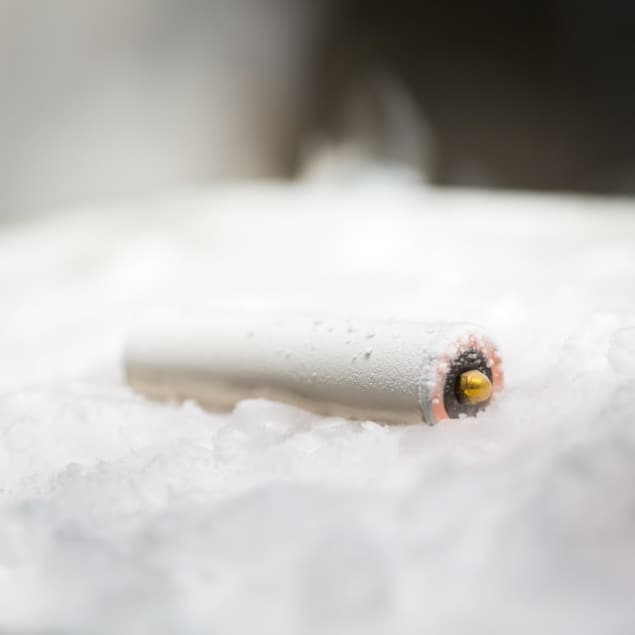
The lithium-ion anode is the material of choice in battery applications thanks to its high specific capacity of 3.860 Ah/g and low electrochemical potential of –3.04 V. In practice, however, the performance of lithium falls far short of its theoretical potential because it has a low Coulombic (cycling) efficiency. Another reason is that it is incompatible with conventional electrolytes, which leads to needle-like dendrite formation on the anode surface during battery operation. As well as degrading battery efficiency and reducing battery life by creating a porous Li-metal structure that consumes both active Li and electrolyte, these dendrites can also create short circuits and in some cases, cause devices to explode.
Liquified gas electrolytes could help overcome this problem. These electrolytes, first reported on in 2017, are made, as their name suggests, from liquified gas solvents. They function at both room temperature and at very low temperatures (down to –60 °C) because they are more resistant to freezing than standard electrolytes.
Dendrite-free Li-metal cycling
Researchers at the University of California San Diego (UCSD) and the UCSD spin-off company South 8 Technologies led by Shirley Meng and Cyrus Rustomji studied the fluoromethane (CH3)-based liquified gas electrolyte. Previous work showed that this electrolyte allows for dendrite-free Li-metal cycling with a relatively high efficiency (of 97.5%) by forming a dense, uniform, ceramic-based solid-electrolyte interface (SEI) composed mainly of LiF and Li2CO3 salt on the Li anode surface. This SEI is different to the inhomogeneous SEI that forms with conventional electrolytes, which is unstable and produces dendrites.
In the previous work, researchers found that the cell performance of liquified gas electrolytes was limited because the lithium salt has limited solubility in the electrolyte , which leads to high polarizations. Meng and colleagues have now overcome this problem by adding small amounts of tetrahydrofuran as a co-solvent to the electrolyte. What is more, they say that they now fully understand the solvation structure and improved lithium transport in the electrolyte thanks to electrolytic conductivity measurements and molecular dynamics simulations.
Unlike typical electrolytes
For one, the conductivity versus temperature curves of the liquefied gas electrolytes do not follow that of typical electrolytes, they say. Because of the exceptionally low melting point of the fluoromethane, its minimal viscosity, and high dielectric-fluidity factor, the conductivity is well maintained at low temperatures. Indeed, the conductivity is considerably enhanced with an increase in concentration of the salt and additive while still following the same temperature trends as the fluoromethane-based electrolyte without the addition of tetrahydrofuran, explain the researchers.
“The unique properties and solvation structure of liquified gas electrolytes result not only in high overall conductivity but also in the unusually high contribution of the lithium cation to conduction that is highly desirable,” says team member Oleg Borodin of the Army Research Laboratory. “The fluoromethane-based liquid gas electrolytes containing additive amounts of tetrahydrofuran also fully coordinate with lithium cations and greatly enhance salt dissection and transport.”
The electrolyte also boasts a lithium transference number of more than 0.79, a low viscosity, low melting point and high dielectric fluidity factor, he tells Physics World. It also forms a stable F-rich SEI with the Li metal anode that has significantly lower resistance than traditional electrolytes.
Less than 1% porosity
The high transference number, low viscosity and stable SEI are key for lithium metal cycling, to prevent dendrite growth and allow for dense, smooth Li deposition. The researchers proved this by measuring the porosity of lithium deposition on the current collector in their battery using a cryogenic-focused ion beam and 3D reconstruction. The porosity with liquified gas electrolytes is just 0.90% at room temperature. To compare, this increases to nearly 17% with conventional electrolytes.

Graphite lithium-ion batteries get a boost from halogen intercalation
The low viscosity and melting point enable higher conductivity down to low temperatures, which results in impressive Li metal cycling efficiency at these temperatures – even at a high cycling rate. Indeed, the researchers found the cycling efficiency of the lithium-anode in their experiments was 99.6% for 500 charge cycles at room temperature. This is better than the 97.5% reported in 2017 and the 85% for the anodes in a conventional (liquid) electrolytes. At –60 °C, this value drops slightly to 98.4%. A feat in itself since most conventional electrolytes do not work below –20 °C.
Until now, researchers have mainly been studying high concentration liquid electrolyte or electrolyte systems for improving lithium-anodes, but liquified gas electrolytes could be more promising, say Meng and colleagues – especially for low-temperature operation applications.
“South 8 Technologies, is now commercializing this technology”, says team member Yangyuchen Yang. “Our research group is also focusing on better understanding these electrolytes and optimizing them based on both modelling and experimental studies.”
The research is detailed in Joule 10.1016/j.joule.2019.06.008.



